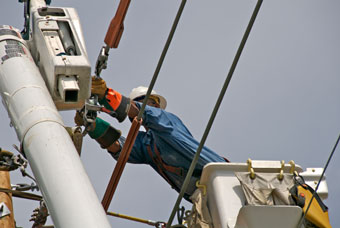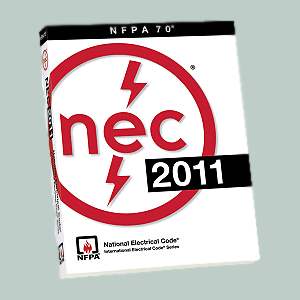
Personnel safety around energized equipment is only part of the picture when it comes to electrical safety. The other part is the installation, and whether the job was performed correctly.
NFPA-70 National Electric Code
The National Electric Code (Figure 1) is a legal requirement that has been adopted by the authority having jurisdiction. This means that if a state, county, municipality, or local government adopts the code, it then becomes law. The latest revision is the 2011 version. The stated purpose of the code is “the practical safeguarding of persons and property from hazards arising from the use of electricity.”

Figure 1: National Electric Code (NFPA 70)
NFPA-70B Recommended Practice for Electrical Equipment Maintenance
The purpose of this code book is to reduce hazards to life and property that can result from failure or malfunction of industrial-type electrical systems and equipment. The book gives recommended tests and maintenance schedules for various classes and types of electrical equipment and systems.
Training for a Qualified Electrical Worker
A qualified electrical worker should be trained and knowledgeable of the construction and operation of equipment or a specific work method, and be able to recognize and avoid the electrical hazards that might be present with respect to that equipment or work method.
a. Such qualified electrical workers will also be familiar with the proper use of the special precautionary techniques and PPE, including arc flash, insulating and shielding materials, and insulated tools and test equipment. A proficient electrical worker is considered qualified with respect to certain equipment and methods but still unqualified for others.
b. An electrical worker who is undergoing on-the-job training and who, in the course of such training, has demonstrated an ability to perform duties safely at his or her level of training, and who is under the direct supervision of a qualified electrical worker will be considered to be a qualified electrical worker for the performance of those duties.
c. Such qualified electrical workers permitted to work within the flash hazard boundary of exposed energized electrical conductors and circuit parts operating at 50 volts or more will, at a minimum, be additionally trained in all of the following:
i. The skills and techniques necessary to distinguish exposed energized electrical conductors and circuit parts from other parts of electrical equipment.
ii. The skills and techniques necessary to determine the nominal voltage of exposed energized electrical conductors and circuit parts.
iii. The approach distances specified by the company-approved arc flash label and the corresponding voltages to which the qualified electrical worker will be exposed.
iv. The decision-making process necessary to determine the degree and extent of the hazard, the PPE, and job planning necessary to perform the task safely.
Definitions
Electrical Hazard: A dangerous condition such that contact or equipment failure can result in electric shock, arc flash burn, thermal burn, or blast.
Electrical Safety: Recognizing hazards associated with the use of electrical energy and taking precautions so that hazards do not cause injury or death.
Awareness and Self-Discipline
- Maintain awareness of the potential electrical hazards
- Provide the required self-discipline, safety principles, and controls for technicians who occasionally must perform work that may involve electrical hazards
- Instill safety principles and controls
Electrical Safety Program Principles
- Inspect/evaluate the facilities’ electrical equipment
- Maintain the insulation and enclosure integrity of the electrical equipment
- Plan each job and document procedures done for the first time
- De-energize equipment prior to working on any electrical equipment unless troubleshooting that piece of equipment
- Be alert for unanticipated events or problems
- Identify and minimize all hazards associated with the work area
- Protection of the technician from shock hazard, arc flash/blast, and other hazards associated with the work/area
- Using the right tools for the job
- Assessing the abilities of the individuals working on the equipment
- Auditing the process to determine the level of compliance with the program
Electrical Safety Program Controls
- Unless proven otherwise, all electrical equipment and conductors will be considered alive
- Bare-hand contact is not to be used on exposed energized conductors or circuit parts above 50 volts to ground
- Place all electrical equipment in an electrically safe condition unless troubleshooting or testing
- Develop training for technicians, and ensure that they apply what is learned
- Develop and use procedures to identify hazards, and develop plans to reduce and/or eliminate them
- Train and qualify technicians to work around or near exposed energized electrical equipment or conductors
- Use a systematic and logical approach to determine the potential hazards associated with each task
Electrical Safety Program Procedures
- Purpose of the task to be accomplished
- Number of qualified electrical workers involved in accomplishing the task
- Hazards associated with task
- Limits of approach/flash hazard boundary
- Safe work practices to be used
- PPE required for task
- Insulation class for materials and tools to be used
- Any specialized precautionary techniques to be used
- Electrical prints associated with the task
- Equipment manual and instructions pertinent to the task
- Other material needed to define or show unique features
- Other reference materials deemed necessary
Hazard/Risk Evaluation Procedure
Identify a hazard/risk evaluation procedure to be used before work is started on or near energized electrical conductors, circuit parts operating at 50 volts or more, or where an electrical hazard exists.
Working On or Near Electrical Conductors or Circuit Parts
According to the NFPA70E, “working on energized electrical conductors or circuit parts” involves coming into contact with energized electrical conductors or circuit parts with the hands, feet, or other body parts or with tools, probes, or with test equipment, regardless of the personal protective equipment a person is wearing.
There are two categories of “working on.” The first category is diagnostic testing, which is the taking of readings or measurements of electrical equipment that does not require making any physical change to the equipment. Repair is the second category, which is the physical alternation of electrical equipment, such as the making or tightening of connections, removing or replacing components, etc.
The major difference between the two categories is that performing diagnostics does not require written permission, while the performance of a repair on equipment that is not in an electrically safe work condition will typically require a written job plan, permission from management before performing the task, and should only be performed if at least one of the four requirements stated by OSHA and the NFPA are met.
Visual inspections of operating equipment are allowed; however, setting an electrically safe work area and full compliance with PPE requirements must be accomplished before conducting the visual inspection.
For more information on Electrical Safety and NEC, sign up for our online training at www.myodesie.com or contact us at sales@techtransfer.com for a class at your facility.

